Energy drink usage among university students in a Caribbean country: Patterns of use and adverse effects
- DOI
- 10.1016/j.jegh.2014.05.004How to use a DOI?
- Keywords
- Energy drink side effects; Jolt and crash; Rum and Red Bull; Trinidad and Tobago
- Abstract
Objective: There has been little inquiry addressing whether or not concerns about adverse effects of energy drink usage are relevant in the Caribbean. This survey investigated energy drink usage and adverse consequences among tertiary level students in Trinidad and Tobago.
Methods: A cross-sectional survey of 1994 students from eight institutions was conducted using a de novo questionnaire based on findings from a focus group of students. Chi-squared analyses and logistic regression were used to assess relationships between energy drink usage, adverse effects and other factors affecting energy drink use, and to verify predictors of energy drink use.
Results: Prevalence of use was 86%; 38% were current users. Males were more likely to use, used more frequently and at an earlier age. Energy drinks were used most commonly to increase energy (50%), combat sleepiness (45%) and enhance academic performance (40%), and occurred during sports (23%) and mixed with alcohol (22.2%). The majority (79.6%) consumed one energy drink per sitting; 62.2% experienced adverse effects, most commonly restlessness (22%), jolt and crash (17.1%) and tachycardia (16.6%). Awareness of adverse effects was associated with no use (p = 0.004), but adverse effects were not a deterrent to continued use.
Conclusion: Energy drink usage is prevalent among students. The use is not excessive, but associated with high rates of adverse effects and occurs in potentially dangerous situations like during exercise and with alcohol. There is a need to educate students about the potential adverse effects of energy drinks.
- Copyright
- © 2014 Ministry of Health, Saudi Arabia. Published by Elsevier Ltd.
- Open Access
- This is an open access article under the CC BY-NC-ND license (http://creativecommons.org/licenses/by-nc-nd/4.0/).
1. Introduction
Over the last two decades, energy drinks have experienced dynamic global growth in popularity [1]. The Caribbean has not been exempted from aggressive marketing. In spite of the ready availability of energy drinks, to date there has been little inquiry into patterns of consumption, effects of use and whether or not concerns about the adverse effects of the stimulant content are relevant in this region. Energy drink usage among university students is of particular concern since this youthful population, engaged in academic pursuit is an ideal target for the promoters of energy drinks, with promises to boost energy, promote wakefulness, increase alertness and improve mental and physical performance.
Previous reports have shown that energy drink usage in this population is prevalent globally. Among undergraduate university students in the United States, 39–80% had used at least one energy drink in the past [2–6], with the highest rates occurring among students who participate in athletics [6]. In Ghana, 62.2% of student athletes used energy drinks at least once weekly [7], and in Argentina the ever used prevalence among students of physical education was 64.9% [8]. Ever used prevalence rates are also reported among various university student groups in Saudi Arabia (40%) and Turkey (32.6%) [9,10]. Kopacz et al. reported the use of energy drinks by 49% of university students in Poland and noted that the quantity of energy drinks consumed during examinations was significantly greater than that during the academic year [11].
The potential adverse effects of energy drinks are in large part related to the stimulant caffeine, the main ingredient which provides the desired energy rush. Most energy drinks contain about 80 mg of caffeine per serving [1,12], the same amount as an eight ounce cup of coffee. Some, however, provide up to an estimated 300 mg of caffeine in a single serving [1,12]. Most also contain large quantities of sugar and other substances such as taurine, riboflavin, pyridoxine, nicotinamide, B vitamins, and various stimulating herbal derivatives (guarana, ginseng and ginkgo biloba) [13].
The U.S. Food and Drug Administration reports that the moderate use of caffeine is safe [14] – a position endorsed by the American Medical Association Council on Scientific Affairs [15]. A daily dose of 300 mg of caffeine or less is considered a moderate intake [16]. Daily consumption of more than 400 mg is considered a high intake and has been associated with a variety of adverse health effects, including anxiety, insomnia, irritability, dehydration, nervousness, elevated blood pressure and accelerated heart rate [17,18]. Previous studies have shown that college and university students are ignorant of the adverse effects of energy drinks [19] although not immune from them [2].
Trinidad and Tobago, the southernmost country in the Caribbean, is a high-income developing country with a population of 1.3 million (2011) and a per capita GDP of 18,087 USD [20]. Little is known about the use of energy drinks among students in the Caribbean. This survey determined consumption patterns and occurrence of adverse effects among students in tertiary level institutions in Trinidad and Tobago. This information would be useful in informing interventions and policy recommendations pertaining to the use of energy drinks on the campuses of tertiary institutions in Trinidad and Tobago and the wider Caribbean.
2. Material and methods
2.1. Student survey
A cross-sectional survey of students in all tertiary institutions in Trinidad and Tobago was conducted. Approval was obtained from the Ethics Committee of the Faculty of Medical Sciences, University of the West Indies (UWI), St. Augustine campus. Nine tertiary institutions were approached and eight agreed to participate.
A questionnaire was designed to obtain data on student demographics, energy drink consumption patterns, associated adverse effects, and knowledge of the adverse effects of energy drinks. The design of the questionnaire was guided by findings from a focus group of 15 randomly chosen students in the UWI, St. Augustine School of Medicine, which collected data related to energy drink usage – circumstances of use, frequency patterns, brands used most commonly, quantity consumed and adverse effects experienced after use. The resulting 25-item questionnaire was piloted among 20 random students on the UWI campus, and minor modifications were made to the instructions for clarity.
A convenience sample was utilized. Quota sampling based on student enrollment ensured adequate representation of each institution. A representative number of students per faculty/department for each institution was determined using student census data in each faculty/department. Using lists of classes, timetables and class sizes, students were recruited from selected classes on different days of the week and times of day.
The sample comprised 1994 full- and part-time students enrolled in all departments of the eight institutions that agreed to participate. Students were informed of the purpose of the study and anonymously completed a self-administered questionnaire. There was an 85% response rate. The only exclusion criterion was the previous completion of the questionnaire. Data were collected between 1 March and 31 August 2011.
2.2. Statistical analysis
Statistical analysis utilized the Statistical Package for the Social Sciences (SPSS) version 17. Descriptive and frequency statistics were determined. Chi-squared analyses and logistic regression were used to assess relationships between energy drink usage, adverse effects and other factors affecting energy drink use, and to verify predictors of energy drink use.
3. Results
3.1. Characteristics of respondents (Table 1)
The sample was predominantly female (65.6%) under the age of 30 years (78.8%) pursuing undergraduate courses (94.1%). Most were within the first two years of studies (78.6%).
| Characteristic | Categories | n (%) |
|---|---|---|
| Institution | UWI | 855 (42.9) |
| UTT | 326 (16.3) | |
| COSTATT | 323 (16.2) | |
| USC | 250 (12.5) | |
| ROYTEC | 92 (4.6) | |
| TTHI | 60 (3.0) | |
| SAMS | 45 (2.3) | |
| SITAL | 38 (1.9) | |
| Missing | 5 (0.3) | |
| Age group (years) | 19 and under | 434 (21.8) |
| 20–29 | 1136 (57.0) | |
| 30–39 | 235 (11.8) | |
| 40 and older | 148 (7.4) | |
| Missing | 41 (2.1) | |
| Gender | Male | 681 (34.2) |
| Female | 1308 (65.6) | |
| Missing | 5 (0.3) | |
| Marital status | Single | 1629 (81.7) |
| Married | 271 (13.6) | |
| Common-law | 39 (2.0) | |
| Divorced/widowed | 44 (2.2) | |
| Missing | 11 (0.6) | |
| Ethnicity | African | 716 (35.9) |
| East Indian | 657 (32.9) | |
| Mixed | 566 (28.4) | |
| Other | 42 (2.1) | |
| Missing | 13 (0.7) | |
| Type of degree | Undergraduate | 1877 (94.1) |
| Postgraduate | 64 (3.2) | |
| Missing | 53 (2.7) | |
| Year of study | 1st | 880 (44.1) |
| 2nd | 687 (34.5) | |
| 3rd | 258 (12.9) | |
| 4th or more | 150 (7.5) | |
| Missing | 19 (1.0) |
Characteristics of respondents (n = 1994).
3.2. Energy drink usage
Thirty-eight percent of students (n = 758) reported current use of energy drinks (EDs) (use in the last month); 86.2% used an ED at least once (n = 1718). Logistic regression indicated that males were more likely to have ever used than females, p = 0.001, CI = 0.64 (0.47, 0.83). Chi square test showed that students over 40 years of age were least likely to use EDs, χ2(1, N = 1657) = 16.65, p = .001. The commonest brands of EDs preferred by current users are shown in Table 2 by sex, with the reported caffeine content.
| Type of ED | *Amount of caffeine mg/can | Male n (%) | Female n (%) | Total number n (%) |
|---|---|---|---|---|
| Monster | 92 | 127 (48.1) | 123 (29.9) | 250 (37) |
| Red Bull | 83 | 69 (26.1) | 141 (34.2) | 210 (31) |
| Full Throttle | 210 | 29 (11) | 48 (11.7) | 77 (11.4) |
| 5 Hour Energy | 215 | 8 (3) | 16 (3.9) | 24 (3.6) |
| Battery | n/a | 3 (1.1) | 3 (0.7) | 6 (0.9) |
| Shark | n/a | 1 (0.4) | 1 (0.2) | 2 (0.3) |
| Other | 27 (10.2) | 80 (19.4) | 107 (15.8) | |
| Total | 264 (100) | 412 (100) | **676 (100) |
Consumer Reports December 2012, http://www.consumerreports.org/cro/magazine/2012/12/the-buzz-on-energy-drink-caffeine/index.htm.
Missing = 82.
Type and caffeine content of the energy drink mainly consumed by current users, by sex (n = 676).
3.3. Initiation of ED usage
Seventy-six percent of males and 66% of females began the use of EDs before the age of 20 years. Analysis of logistic regression showed that males were 1.59 times more likely to initiate use before the age of 20 years, p < 0.001, CI = 1.59 (1.27, 2.04). Among current users, a modal 47.5% initiated use between the ages of 16 and 20 years (n = 360). ED use was less likely to start after the age of 25 years (2.5%), while 8.3% of respondents indicated that use began before the age of 10 years.
Table 3 shows the main avenues through which ED usage began. Other modes of initiation included through a physician, while playing sports or working out, curiosity, peer pressure, ED promotion/free samples, and for rehydration. Chi square test indicated that males were more likely to begin the use of EDs through advertisements and seeing them at the store, while females began through recommendations from family and friends and in social settings χ2(4, N = 1620) = 14.37, p = .006. The main factors influencing the choice of EDs among ever users were effectiveness (33.7%), taste (29.5%) and through recommendation (10.7%). Males were significantly more likely to select an energy drink based on the popularity of the brand. Female respondents selected drinks based on the effectiveness.
| How student was introduced | Male n (%) | Female n (%) | Total | p Value |
|---|---|---|---|---|
| Advertisements | 182 (31.2) | 314 (30.3) | 496 (30.6) | 0.006 |
| At the supermarket/store | 103 (17.7) | 130 (12.5) | 233 (14.4) | |
| Recommendations from friends and family | 160 (27.4) | 345 (33.3) | 505 (31.2) | |
| Social settings | 102 (17.5) | 203 (19.6) | 305 (18.8) | |
| Other | 36 (6.2) | 45 (4.3) | 81 (5) | |
| Total | 583 (100) | 1037 (100) | 1620* (100) |
Missing = 98.
Mode of introduction to energy drinks (n = 1718).
3.4. Pattern of use among current users
Among current users of energy drinks (n = 758), the average number of EDs consumed in a typical month ranged from one to more than 40 (n = 2); most (74%) reported using five or less drinks in the average month. Most students (66.9%) reported use on less than 3 days over the prior month; 1.8% drank on most days of the month (>21 days). Logistic regression showed that males were twice as likely as females to have consumed EDs for more than 7 days in the last month p < 0.001, C.I. = 2.04 (1.36, 3.02). Most current ED users (79.6%) consumed no more than one drink in a typical setting. Sixteen percent of students would have two EDs in one sitting, and 2.8% reported the use of 3 or more. Males (21.7%) were more likely to consume more than one ED in a single sitting than females (17.2%), but this was not a statistically significant gender difference. In the sample, 60.2% and 36.9% of students also revealed weekly consumption of coffee and tea, respectively, as additional sources of caffeine.
3.5. Reasons for use of energy drinks
Fifty percent of students who ever used EDs were seeking a boost in energy. Other popular reasons for use included staying awake (45%) and studying/doing a major project (40%). Less than 10% of students used EDs for weight control, sexual stamina, as a mental enhancer or to treat a hangover. Almost one-quarter (23.1%) of students used EDs while playing sports and as a mixer with alcohol (22.3%). Table 4 shows reasons for the use of EDs among ever users.
| Reason for using | No. of students who used energy drinks for each reason (%) |
|---|---|
| Energy boost | 860 (50.1) |
| Staying awake | 773 (45) |
| Studying or major project | 687 (40) |
| Sports | 397 (23.1) |
| Mixing with alcohol while partying | 383 (22.3) |
| Mental enhancer | 123 (7.5) |
| Stamina (sexual intercourse) | 88 (5.1) |
| Treating hangovers | 38 (2.2) |
| Weight control | 13 (0.8) |
Reasons for using energy drinks among ever users (n = 1718).
3.6. Effects of energy drinks
Among students who ever used EDs, 53% did not attain the effect they were seeking as described in Table 4. Those who attained their desired effect after consuming an ED were 61% more likely to continue use. Among students who were past users of EDs, 65.3% had not attained the desired effect after use, compared with 34.7% of current users, χ2(1, N = 1566) = 80.78, p = .001.
3.7. Adverse effects of energy drinks (Table 5)
Of respondents who had ever used EDs (n = 1718), 62.2% had associated adverse effects. The commonest effects were restlessness (23.3%), the jolt and crash effect (18%), and tachycardia (17.5%). Males and females were equally likely to experience adverse effects. More than half of the sample (58.8%) were aware of the potential adverse effects of excessive ED usage. Logistic regression indicated that students who were aware of the adverse effects were significantly less likely to have ever drank an ED than students who were not, p = 0.004, CI = 0.66 (0.50, 0.88). There was no significant association between students who experienced adverse effects and current use of EDs.
| Symptoms experienced | No. of students who experienced each symptom n (%) |
|---|---|
| None | 613 (35.7) |
| Restlessness | 378 (22) |
| Jolt and crash | 293 (17.1) |
| Elevated heart/pulse rate | 285 (16.6) |
| Anxiety | 229 (13.3) |
| Increased urination | 199 (11.6) |
| Insomnia | 192 (11.2) |
| Twitch or tremor | 146 (8.5) |
| Headache | 130 (7.8) |
| Irritability | 134 (7.8) |
| Other* | 31 (1.8) |
Some of the other symptoms experienced by students after use included sleepiness, lethargy, chest pains, dehydration, excessive thirst, diarrhea, increased alertness, memory impairment, increased sweating, nerve tingling, vomiting, dry mouth, nausea and paranoia.
Symptoms experienced by ever users after using energy drinks (n = 1718).
4. Discussion
This study, the first known national student survey of energy drink usage in the Caribbean, demonstrates the popularity of energy drinks among students attending tertiary institutions. More than 86% of students had ever consumed energy drinks, most commonly for increased energy, wakefulness and when studying or doing projects. This is at the higher end of the ever used prevalence range described in other studies of energy drink use among university students (39–80%) [2–11]. Thirty-eight percent of the sample were current users of energy drinks, having consumed within the last month. This is more consistent with the current use prevalence reported in other student populations (22.6–62.2%) [2–5,7,21].
Student use was commonly initiated through the influence of advertisements. This is not surprising since the advertisements are very appealing, targeting individuals with fast-paced lifestyles looking for an energy boost, including tertiary level students wanting to sustain long hours of study, party-goers, and extreme sports players. In addition, distributors of EDs in the Caribbean sponsor and endorse popular parties where the EDs are promoted as mixers for alcoholic drinks. They also support competitions on university campuses when EDs are distributed at no cost and as prizes. This aggressive marketing may explain why students in this study were most likely to initiate ED use because of advertisements while other studies reported peer influence and curiosity about taste and effects as the main reasons for ED initiation [9,19].
Over 12 brands of EDs are available in Trinidad and Tobago without restriction. The ready availability and the influence of friends or relatives were also common incentives for use by students. This, together with the young age at which ED usage begins is alarming. Most students began use during adolescence, and almost 10% before the age of 10 years. Safe limits of ED usage for children and adolescents have not been established. Worldwide there are increasing reports of caffeine toxicity among children and adolescents, and deaths in children with undiagnosed underlying medical conditions [18,22]. The more popular energy drinks, Monster and Red Bull, contain on an average 85 mg of caffeine. The average regularly consuming tertiary level student in Trinidad and Tobago drinks one can in a single setting and no more than five in the average month. More than 400 mg of caffeine daily is considered a high intake [18], so even if energy drinks with higher caffeine levels are consumed (average 210 mg), it is reasonable to conclude that on an average these students use energy drinks but do not consume high or dangerous amounts of caffeine in this form.
According to Nawrot’s review of studies on human consumption of caffeine, used in moderation, caffeine generally does not produce detectable side effects [16]. In this sample of mainly 20–29 year, over 62% experienced a wide range of adverse consequences even with the reported moderate rates of consumption. Similarly high rates of adverse effects (74.5%) have been reported among the university student population in Saudi Arabia [9], but not among college students in the United States where only 29% experienced jolt and crash, the most common adverse effect reported from ED usage [2]. This may be because in the latter study, only specific adverse effects were measured. One can only speculate on whether students consuming EDs were sensitive to the effects of caffeine, or whether the self-reported consumption is an under-reporting of actual intake, or whether the quantity of caffeine intake from other sources is excessive. Over 60% of students reported consumption of other caffeinated beverages weekly; however, these other dietary sources of caffeine were not quantified in this survey. Another possible explanation for the high prevalence of caffeine adverse effects is the occurrence of synergism between caffeine and other additives present in EDs. Guarana, kola nut, yerba mate and cocoa are examples of additives that have been reported as sources of caffeine [23]; this points to one of the commonly discussed problems with EDs – the absence of an accurate estimate of caffeine content [1,17,18,23]. There exists no known regulation of the sale or advertisement of EDs in the Caribbean; neither are there regulations governing content labeling, health warnings or cautionary statements about side effects. Thomson and Schiess have reported that the average child, teenager or young adult consuming a single retail unit of an ED above their baseline dietary caffeine exposure, would all, on average, exceed the adverse effect level of 3 mg/kg body weight per day [24]. The rate of caffeine adverse effects found in this survey appears to corroborate this. Experiencing adverse effects from energy drinks was not a deterrent to subsequent use, as no association was found between the experience of adverse effects and current use of EDs.
The early onset of use, high prevalence of adverse effects even with self-reported moderate use, peer and family encouragement to use, and persistent use in spite of adverse effects suggest an unawareness of the dangers associated with ED usage, and highlight the critical importance of educating not just students, but the population at large about EDs and their health risks. Physicians should not be exempted from this since it was reported that the use of EDs has been recommended by physicians. This is reinforced by the fact that students in this survey who had prior knowledge of the potential adverse effects of EDs (58.8%) were significantly less likely to have ever used. This has been previously reported in one study of ED use in children and young adolescents, where awareness of the damage caused by EDs was described as a protective factor reducing the likelihood of use [25].
While a large proportion of students had tried using EDs, more than half of them had not attained the desired effect. Those who perceived a beneficial response were significantly more likely to continue use. As reported in other student populations [2,3,9,19], the commonest reasons for ED usage in both male and female students centered around combating fatigue and sleepiness, and enhancing performance in academic studies. The next most common scenarios for ED use were as mixers with alcohol and while playing sports.
When consumed during exercise or combined with alcohol, EDs have been described as potentially dangerous. Studies have reported an association between ED usage and high risk drinking [3,21,26,27]. The combined use of alcohol and EDs can be dangerous because of the potential to blunt the effects of intoxication [28]. This allows for consumption of dangerous quantities, with the increased risk of alcohol-related risky behaviors, physical consequences and alcohol poisoning [29–31]. In Trinidad and Tobago, “Rum and Red Bull” is a common prescription for socializing which is promoted in song by a popular Grammy award-winning Jamaican reggae artiste. In this survey 27.6% of students admitted using alcohol mixed with EDs.
EDs as an ergogenic aid is of particular appeal to students who engage in sporting activities [7,8,32], but caution has been recommended regarding this use [33]. In this survey, engaging in sports was a reason for initiating use, and over 23% of current users consumed EDs during sporting activities, including, as has been reported in other surveys [7], for rehydration. ED usage for hydration following strenuous physical activity is actually a hazardous practice. The slowed rate of fluid absorption caused by large quantities of carbohydrates contained in energy drinks [34], the diuretic potential [35], plus sweating during physical activity in a tropical Caribbean climate may worsen dehydration with potentially dangerous effects. There is particular caution related to the cardiovascular risk of using EDs after strenuous exercise [36]. The sole known documentation of mortality attributed to energy drink usage in Trinidad and Tobago was death due to myocardial infarction in an adult male with a congenital heart defect, who consumed an ED just before exercise [37]. There is a need for appropriate education about the risks of ED usage, even in small quantities, and exercise.
This study represents a preliminary survey and assumes a representative sample although one institution did not participate. No analyses were done by campus, faculty or department to ascertain differential patterns of use, and risks related to course of study or campus faith-based beliefs. However, useful new knowledge about ED usage among students in tertiary level institutions in one Caribbean country is presented.
Even though students generally do not use excessive amounts of EDs, use is associated with a high prevalence of adverse effects and may occur in dangerous situations, i.e., mixed with alcohol or during sporting activities. This highlights the need for education about the risks of EDs, correction of inaccurate and dangerous perceptions about the usefulness of EDs during exercise and sporting activities, and awareness of the dangers of the “rum and Red Bull” drinking behavior. There is need also to engage students in alternative, healthier ways of coping with academic demands and enhancing performance. With the findings of this study, the Caribbean now has preliminary data to join the international call for interventions concerning EDs, including revised labeling requirements, control over advertising, addressing problematic ingredients and implementing retail restrictions [38], at least for students. Campuses may want to consider health and wellness policies to regulate the sale of EDs. A national prevalence study is recommended to provide evidence for the need of these interventions at a national level, especially among older adults and youth not engaged in tertiary level education.
5. Conclusion
ED usage is prevalent among tertiary level students in Trinidad and Tobago. The use is generally not excessive, but is associated with a high rate of adverse effects and occurs in potentially dangerous situations like during exercise and mixed with alcohol. There is a need to educate students about the potential dangers of EDs and promote health and wellness regarding the use on campuses.
Conflict of interest
There is no conflict of interest to declare.
Appendix
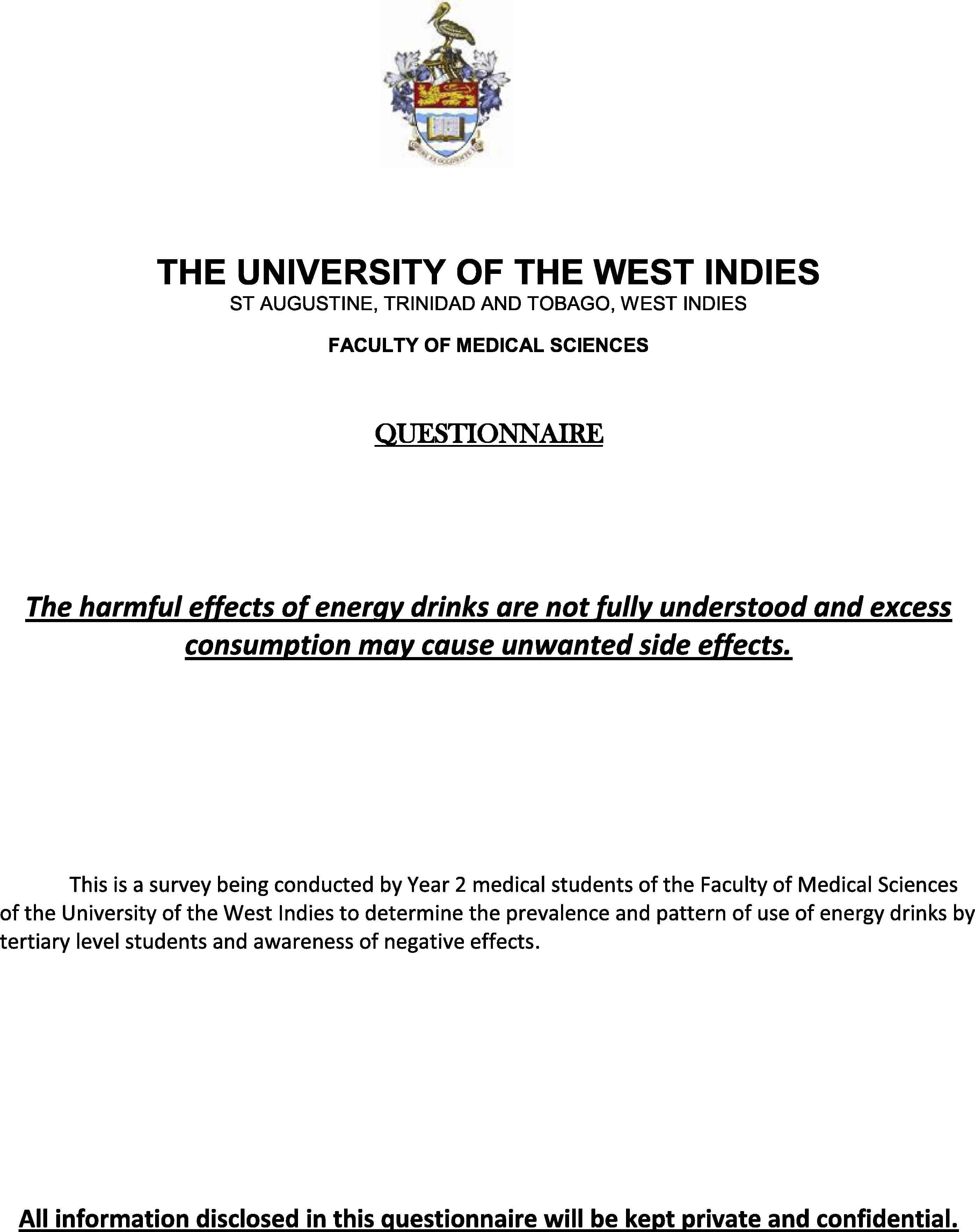

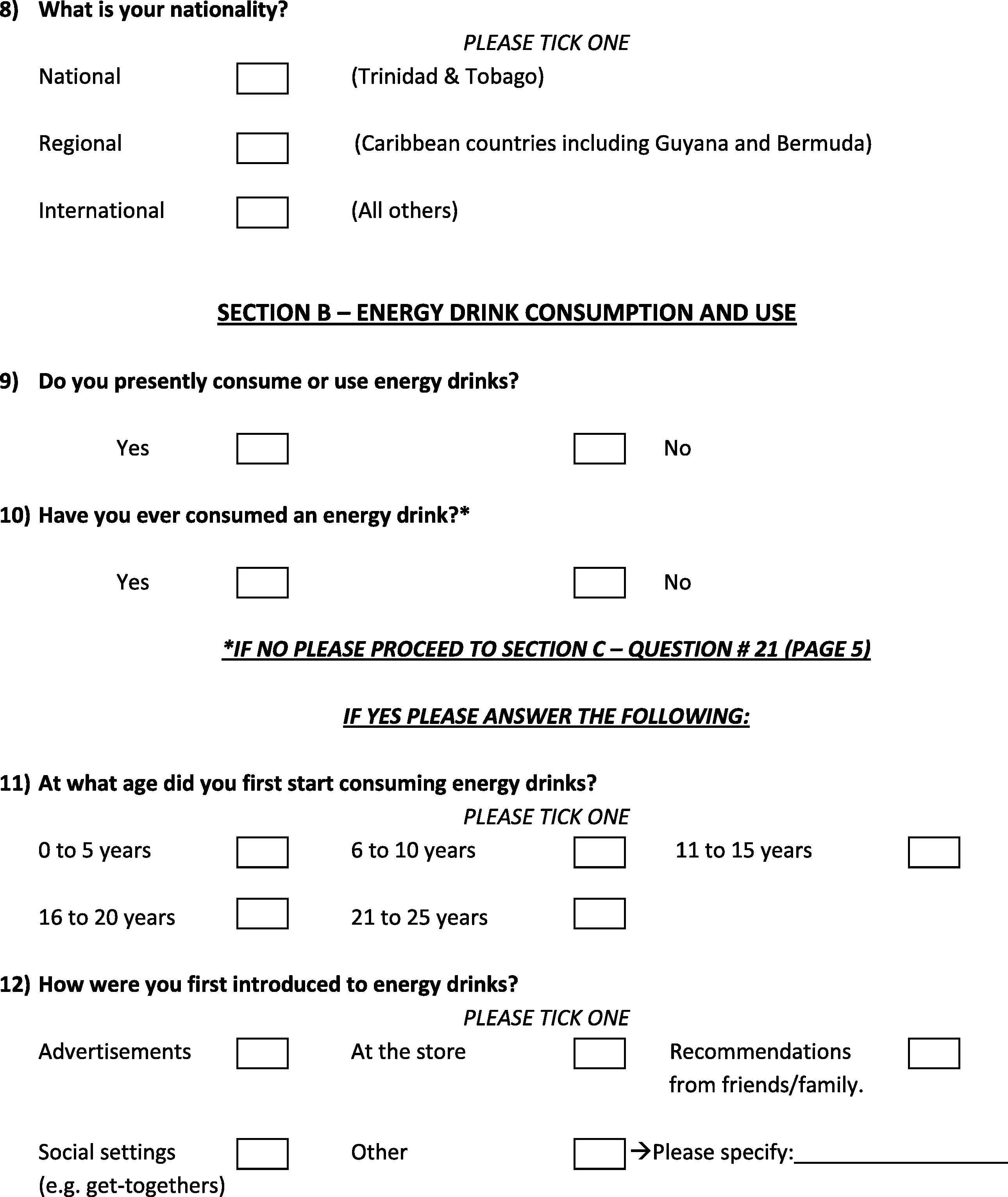
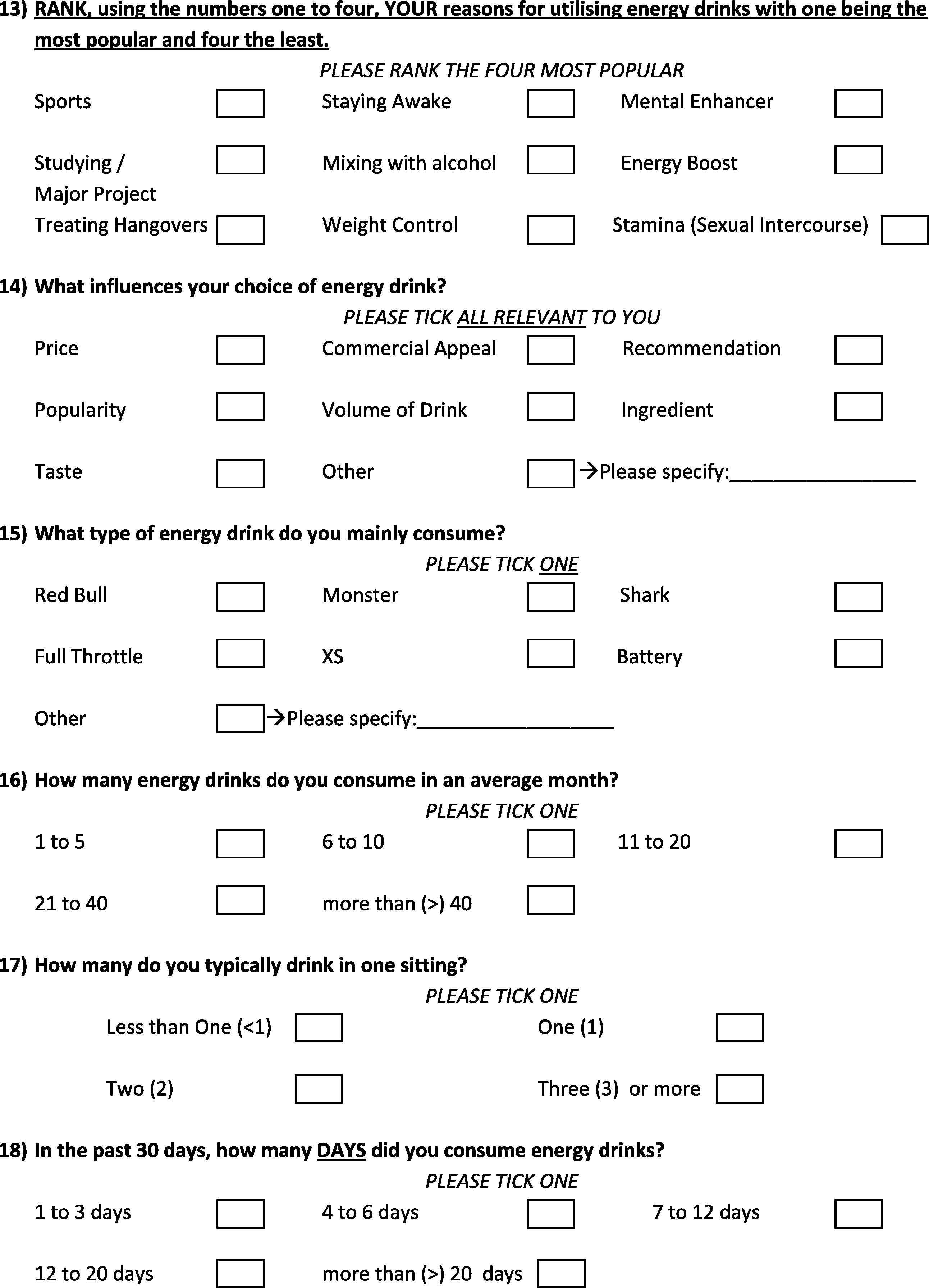
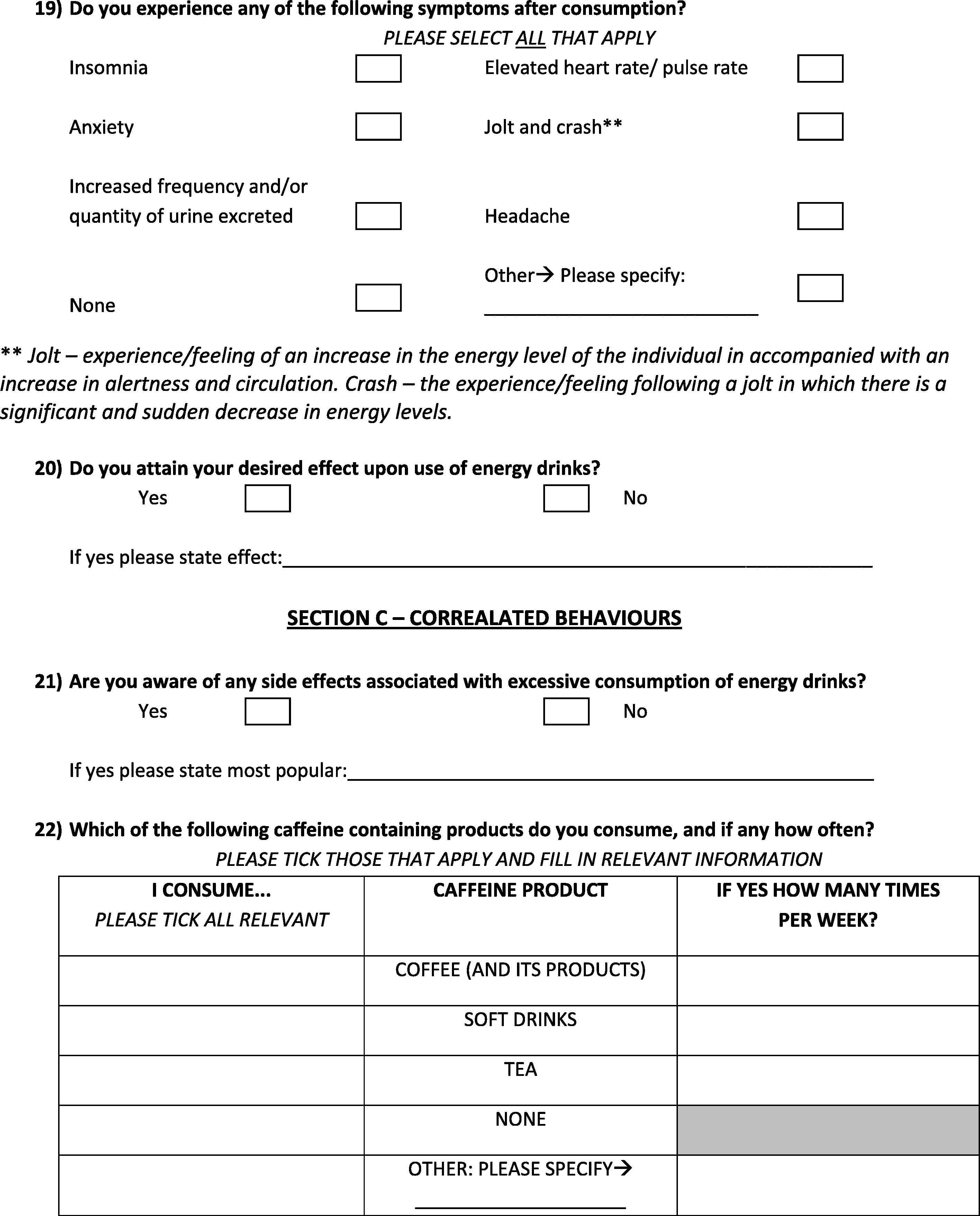
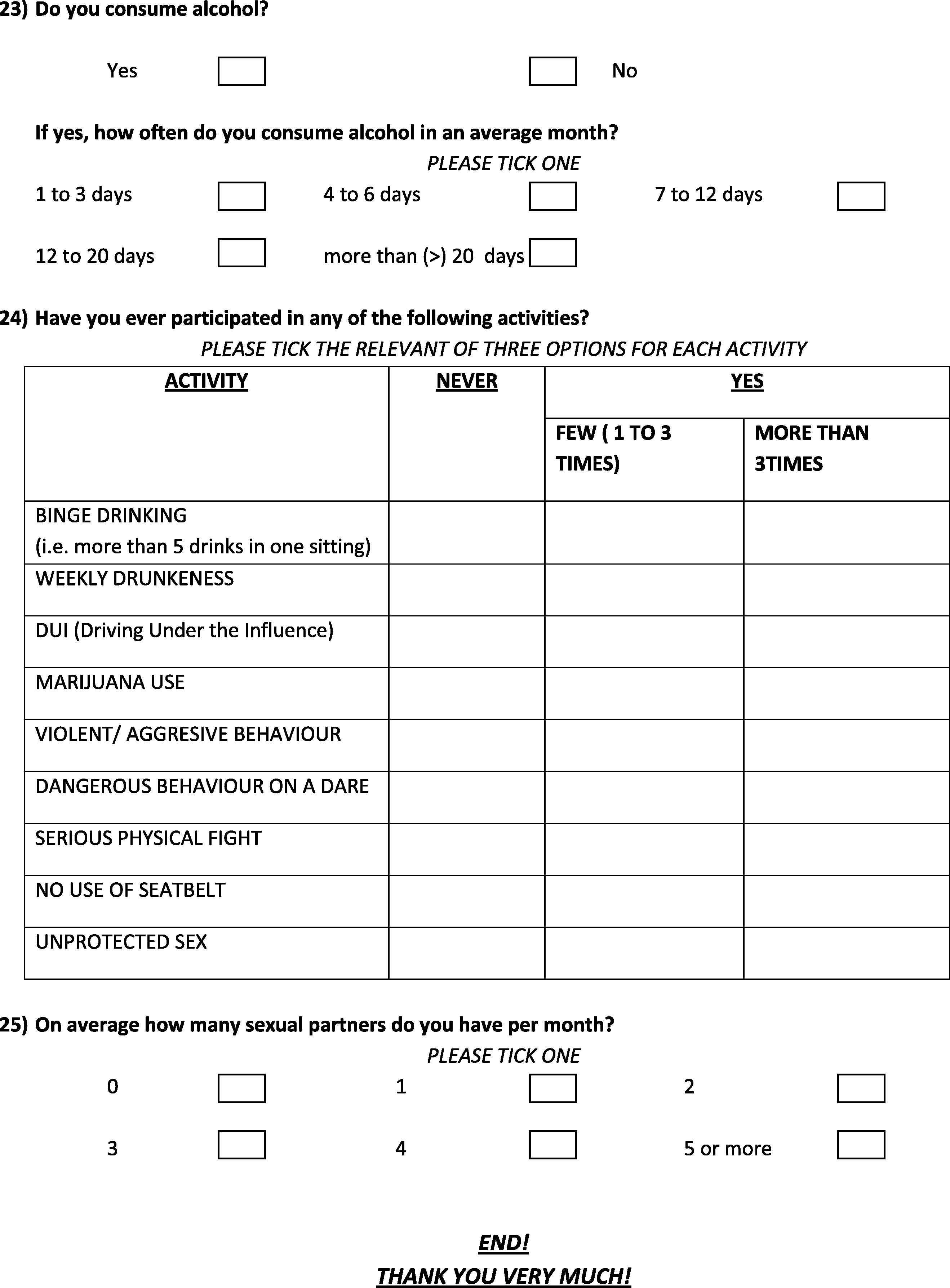
References
Cite this article
TY - JOUR AU - Sandra D. Reid AU - Jonathan Ramsarran AU - Rachel Brathwaite AU - Sarika Lyman AU - Ariane Baker AU - D’Andra C. Cornish AU - Stefan Ganga AU - Zahrid Mohammed AU - Avinash T. Sookdeo AU - Cathrine K. Thapelo PY - 2014 DA - 2014/06/19 TI - Energy drink usage among university students in a Caribbean country: Patterns of use and adverse effects JO - Journal of Epidemiology and Global Health SP - 103 EP - 116 VL - 5 IS - 2 SN - 2210-6014 UR - https://doi.org/10.1016/j.jegh.2014.05.004 DO - 10.1016/j.jegh.2014.05.004 ID - Reid2014 ER -
